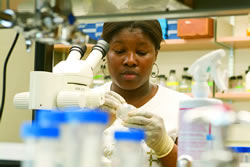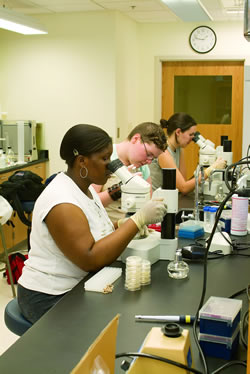 |
 |
 |
||||
 |
|
Cloning
for Clues
Many Oberlin students who study the life sciences are getting a hands-on education in cloning research. Although the cloning of DNA fragments in genes has been part of many college curricula since the 1970s, “not every undergraduate institution is equipped to do molecular cloning research,” says Fran Sharples, director of the Board on Life Sciences in Washington, DC. But Oberlin students are getting a leg up thanks to such cutting-edge tools as the Microaaray—used to look at the expression of most or all of the genes in an organism at one time—and the RNA interface (RNAi), hailed by Wired News as “a new tool that could lead the way for the next wave of blockbuster drugs in biotechnology.” Taylor Allen, associate professor of biology, says the life sciences at Oberlin have worked hard to introduce cloning in their curricula, be it through project-based research courses such as last spring’s Oberlin-in-London course on the Human Genome Project or independent research projects that probe the roles of particular proteins in cellular processes. Cloning was also explored in a recent first-year seminar that delved into the ethical considerations surrounding scientific technology. “Molecular cloning allows us to avoid having to kill animals to study the function of a protein of interest,” says Allen. “This is a great relief to those of us who are attracted to biology because of the wonder of life and are put off by taking away the life of another.” In the laboratory component of Allen’s Animal Physiology (Biology 312), students use molecular cloning to uncover the biological roles of proteins that mutate and cause diseases in humans. Using the roundworm C elegans, which has much in common with humans at the cellular level, students identify genes and their corresponding proteins. A process called a polymerase chain reaction (PCR) allows students to quickly clone fragments of the worm gene, which are then fed to the worms. By analyzing the worm’s deficits in movement, growth, and reproduction, the students can identify the normal roles of proteins encoded by the genes, and thus broaden their understanding of the human diseases linked to the proteins.
Lydia Scheidler ’04 used molecular cloning for her honors research project examining the seasonal occurrence of a mosquito-borne disease that can cause encephalitis in children. Supervised by Associate Professor of Biology Mary Garvin, Scheidler used PCR to test for the presence of the La Crosse encephalitis virus in mosquitoes in Lorain County. The thousands of identical DNA copies gained through PCR enabled Scheidler to amplify signals that indicate the presence of viral DNA into a detectable range. In her project, Scheidler aimed to gain a clearer understanding of the behavior of the virus and its seasonal variation. “I didn’t expect to do cloning at Oberlin, and definitely not in my first year here,” says Tim Kajstura ’07, who worked in a lab with Marta Laskowski, assistant professor of biology. Laskowski uses cloning in her research on lateral root formation in plants. Latera—or branch- roots—are essential to a plant’s ability to derive nutrients from the soil and form in response to certain environmental signals. To find out what’s involved in forming a lateral root, Laskowski identifies the cells that show traits of specific genes. By looking at multiple plant genes at the same time, gained via cloning, her research team can collect data faster. Although cloning specific genes is not the goal of the project, it is a necessary part of the process. "Maybe this isn't as awe-inspiring as cloning humans, but a tool that was unimaginable not so many years ago is now something students at Oberlin know how to use," says Laskowski. Next Page >> |

